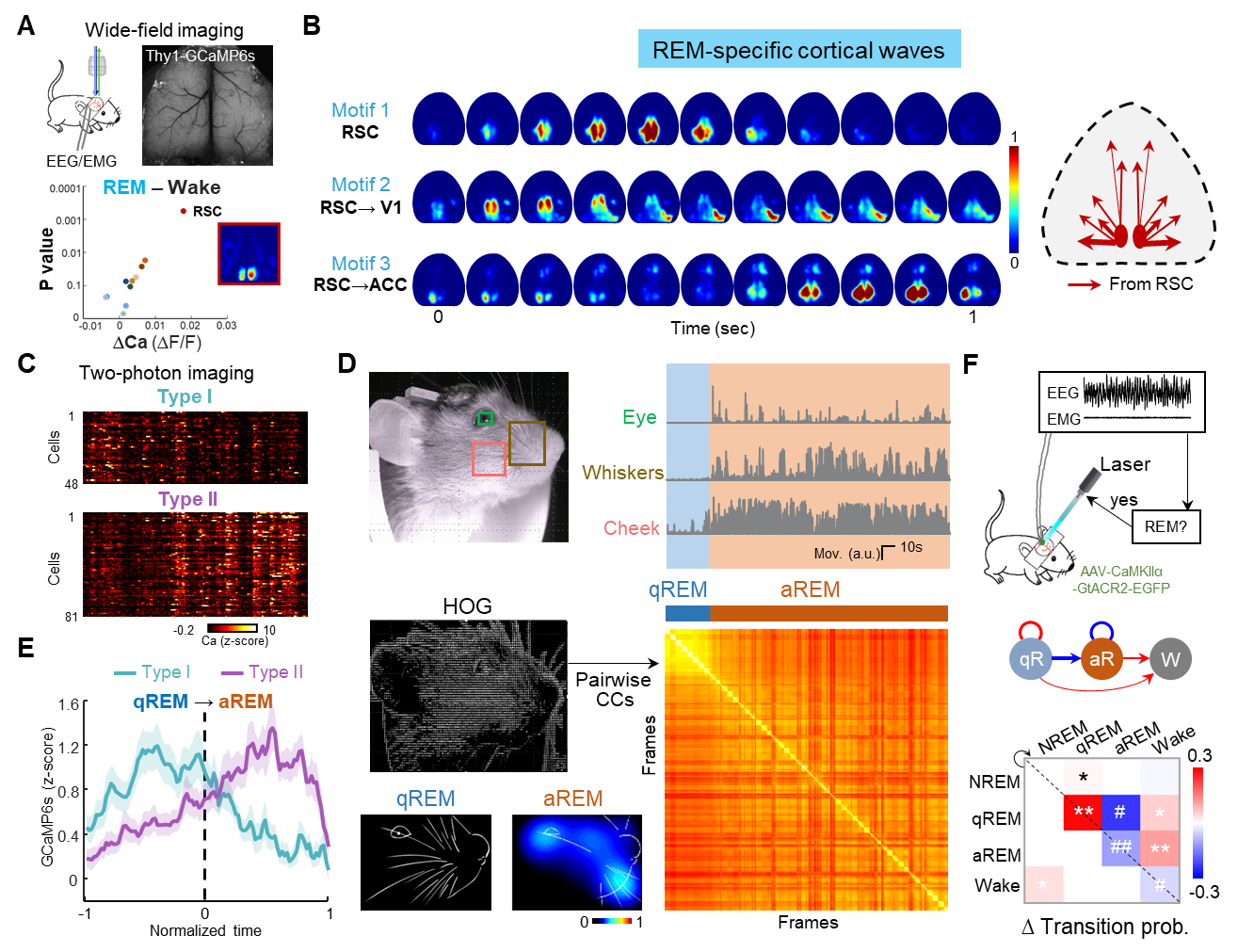Time:2022-11-17
A recent study published in Nature Neuroscience demonstrated that selective retrosplenial cortex activation encodes and regulates the two-stage rapid eye movement sleep (‘REM sleep’). This work was performed by researchers in Dr. LIU Danqian’s Lab at the Institute of Neuroscience, Center for Excellence in Brain Science and Intelligence Technology of the Chinese Academy of Sciences. This work has successfully revealed the cortical activity patterns using large-scale wide-field imaging system and discovered a selectively activated cortical region during REM sleep --- the retrosplenial cortex (‘RSC’), which is the main source of cortical waves during REM sleep as well. At the meantime, this research also discovered and characterized two distinct substages of REM sleep using unsupervised algorithm. Moreover, combining two-photon imaging and optogenetic inactivation experiments, this research confirmed that RSC neuronal activity encodes and regulates the two substage transition. This research lays foundations for understanding cognitive process and regulatory mechanism of spontaneous cortical activation during REM sleep.
REM sleep, first discovered and defined in 1951 by America scientist Eugene Aserinsky, who recorded the Electroencephalogram (‘EEG’) and electro-oculogram (‘EOG’) on his 8-year-old son during sleep, and discovered a special sleep state with bursts of eye movements and high brain activation. In the following studies, he have confirmed that this state is different from normal sleep states with enriched dream, and named it ‘Rapid Eye Movement sleep’, namely REM sleep, and also ‘Dream sleep’. Till now, the mechanism underlying REM sleep regulation, including how the brain can gate external sensory stimulation during REM sleep with such a high brain activation level, and the biological meaning of its existence and the role of this state in brain development are elusive. From the view of evolution, REM sleep appears nearly at the same time with the evolution of the cortex. To this end, studying the brain activity pattern and regulatory mechanism of REM sleep could advance our understanding of the evolution of central nervous system.
In order to investigate whether cortex is participated in REM sleep regulation, researchers implanted a chronic window on Thy1-GCaMP6s mice covering the entire dorsal cortex. They used a two-channel (470nm and 405nm) wide-field imaging system to capture the calcium and hemodynamic signals, with EEG, electromyogram (‘EMG’) and video recording concurrently (Fig A). After spatial independent component analysis (‘sICA’), eleven function modules named each by their corresponding anatomical structure were seperated. Among those modules, RSC exhibited the highest activation than others (Fig A). Moreover, using Granger causality and convolutional non-negative matrix factorization analysis, they found that cortical waves mostly originated from RSC and such waves are specifically happened in REM sleep but not in other brain states (Fig B). Furthermore, researchers discovered that RSC neuronal activation is layer-specific, with selective activation of layer 2/3 instead of layer 5 (Fig C).
Interestingly, by inspection of video recording, researchers found that during REM sleep, mice showed enriched facial movements besides of bursts of rapid eye movement (Fig D). By analyzing the facial movements using unsupervised method to extract the features and cluster, they discovered two substages of REM sleep: with (“aREM”) or without (“qREM”) enriched facial movement (Fig D). These two substages have distinct autonomic activity and differential EEG spectrum in both head-fixed and freely-moving mice, and REM sleep always transit from qREM to aREM. Strikingly, researchers found that RSC L2/3 neuron exhibited two distinct temporal patterns, which highly matched with the two REM substages (Fig E). Using closed-loop optogenetics, researchers finally found that RSC inactivation during REM sleep largely abolished qREM to aREM transition, suggesting that RSC is essential for substage transition. Together, this study found that the RSC L2/3 neuronal activity encodes the two REM substages, and is crucial for REM sleep substage transition (Fig F).
In this work, Liu’s Lab first discovered and defined the two REM substages, depicted spatio-temporal cortical dynamics during REM sleep in mice, and uncovered a critical role of the RSC in REM sleep substage transition. This work is for the first time showing a role for cortex in REM sleep regulation and will pave a way for understanding the complex role of cortical activation during REM sleep. The discovery of two substages will for sure provide a new direction for studying the complex function of REM sleep.
This work entitled “Cortical regulation of two-stage rapid eye movement sleep” was published online in Nature Neuroscience on November 18, 2022. It was completed by DONG Yufan, under the supervision of Dr. LIU Danqian, with the help from LI Jiaqi, ZHOU Min, and DU Yihui. This work was supported by National Natural Science Foundation of China, Chinese Academy of Sciences and Shanghai Municipal Government.

Figure legend: (A) Upper, scheme of two-channel wide-field imaging system. Bottom, activity difference between REM sleep and wake state, with statistical significance (two-sided paired t test) plotted against difference in average Ca2+ ?F/F. Inset shows one of independent module representing “RSC”. (B) Left, three main cortical waves during REM sleep. Right, summary of causality between RSC and other cortical modules. (C) Calcium activity of two types of neurons during REM sleep. (D) REM substages characterization. (E) Normalized calcium activity of two types of neuron in RSC aligned with qREM to aREM transitions. (F) Upper, scheme of close-loop optogenetics inactivation during REM sleep. Bottom, RSCREM inactivation-induced changes in transition probability. The increase transition from Wake to NREM was not shown in the summary plot (middle). */# Increase/Decrease, P<0.05; **/##, Increase/decrease, P < 0.0005, unpaired t test.
https://www.nature.com/articles/s41593-022-01195-2
Keywords: REM sleep, cortex, two-stages
AUTHOR CONTACT:
LIU Danqian
Center for Excellence in Brain Science and Intelligence Technology of the Chinese Academy of Sciences, China.
E-mail: dqliu@ion.ac.cn
 附件下载:
附件下载: